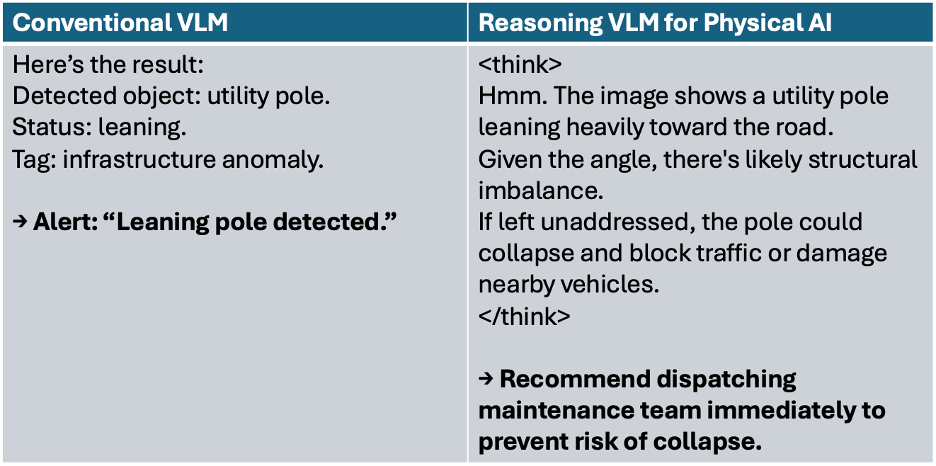Enable Smart Cities with Physical AI—Driven by NVIDIA Cosmos Reason
- Linker Vision

- Aug 11
- 4 min read
Updated: Aug 13
Why Smarter Cities Need Physical AI
Conventional vision language models (VLMs) are great at recognizing objects and detecting patterns. For example, they can tell you that a utility pole is slanted. But that’s where their ability ends. They don’t understand why it’s slanted, what physical forces caused it, or what might happen next. They lack reasoning and an understanding of the real-world physics behind what they see.


This is where Physical AI comes in. It goes beyond simple recognition: it reasons, simulates, and predicts. Physical AI doesn't just say what is happening; it explains why, determines how it affects the environment, and recommends what action to take. For smart cities, this capability has real-world value. It enables systems to anticipate risks before they escalate, prioritize responses based on urgency and impact, and optimize public resources in real time. Whether it's preventing accidents, reducing congestion, or responding to emergencies, Physical AI makes urban environments safer, more efficient, and more resilient. Below is a comparison between conventional VLM and physical AI-based VLM.

This transition from perception to reasoning is not just conceptual, but it requires a sophisticated AI backbone capable of processing cause and effect, running simulations, and making decisions. That’s where NVIDIA Cosmos Reason comes in.
How NVIDIA Cosmos Reason Makes Smart Cities Possible
NVIDIA Cosmos Reason gives us a powerful, 7B-parameter, pretrained foundation. Normally, reasoning vision language models are not just expensive to train, but they’re also GPU-intensive to run during inference. This makes scaling real-time applications like smart cities extremely difficult. But with Cosmos Reason, we bypass both problems. Because we leverage a pre-trained foundation, we’re able to move faster, reduce GPU costs, and focus our efforts on customizing Cosmos Reason instead. This means we can quickly deploy intelligent applications that don’t just detect problems, they understand and solve them. As AI evolves from reaction to true comprehension, NVIDIA Cosmos Reason is the engine that powers that shift.
What is NVIDIA Cosmos Reason?
NVIDIA Cosmos Reason is the third core capability in the NVIDIA Cosmos suite, following Cosmos Predict and Cosmos Transfer. While Cosmos Predict focuses on forecasting future scenarios, and Cosmos Transfer generates synthetic data across domains, Cosmos Reason enables intelligent decision-making by interpreting how the physical world interacts. It uses common sense and prior knowledge of physical rules to gain spatial and temporal understanding of objects moving in real-world environments.
Developed by NVIDIA, Cosmos Reason is a fully customizable, multimodal reasoning model designed to support step-by-step, human-like planning. Rather than stopping at detection or event tagging, it uses chain-of-thought reasoning to infer causes, relationships, and implications.
Trained using a combination of visual-language model post-training and reinforcement learning, Cosmos Reason can explain situations like: “What led to the congestion at this intersection?” or “How did this safety incident unfold over time?”
Integrating NVIDIA Cosmos into the Linker Vision Stack:
Cosmos Reason becomes even more powerful when integrated into a full-stack deployment pipeline, like the one built by Linker Vision. By combining NVIDIA Cosmos Reason with Linker Vision’s Mirra, Dataverse, and Observ platforms, we enable a complete pipeline—from simulation and training to deployment and high-level decision support—making smart city AI more situationally aware, accountable, and proactive.

Our Observ platform already integrates Cosmos Reasoning to detect and interpret real-world hazards like urban flooding. In the scene above, the system not only identifies the presence of ponding, water depth, and pedestrians in the flooded street, but also evaluates risk levels and recommends the appropriate response. For example, it may determine that water accumulation in this zone is likely to increase due to ongoing rainfall, assess the obstruction risk for emergency vehicles, and suggest rerouting traffic or dispatching a response unit. Cosmos Reason might identify that a stalled vehicle in rising water is creating a bottleneck for nearby traffic, or that pedestrians are exhibiting hesitant or unsafe crossing behavior due to limited visibility and unclear walking paths. Rather than simply issuing alerts, Cosmos Reason provides reasoning—explaining why the situation is dangerous, what its impact might be, and what actions should be taken.
To expand the system’s coverage and accuracy, Mirra can be used to simulate additional city-specific flooding scenarios—such as flash floods at underpasses or drainage failure during rush hour—providing synthetic training data for edge cases that are rare but high impact. Dataverse then manages the full lifecycle of these models, incorporating real-world feedback from Observ to continuously fine-tune performance in production environments.
By making these connections, smart cities can reduce accidents, prevent bottlenecks before they form, and deploy emergency services more strategically. This leads to safer streets, faster response times, and more efficient urban operations overall.
Is there supposed to be another image?
Why It Matters
NVIDIA Cosmos Reason brings deliberate cognition to Physical AI systems, enabling infrastructure like cameras, sensors, and edge devices not just to see, but to understand and contextualize what they observe. This elevates raw perception into explainable, actionable insight.
In smart cities, where data is massive, fast-moving, and complex, NVIDIA Cosmos Reason adds a critical layer of predictive logic, explainability, and operational clarity. It makes the entire system more intelligent, more transparent, and more adaptable to real-world conditions.
▶ Contact us if you want to deploy Physical AI at scale through NVIDIA Cosmos Reason:



Comments